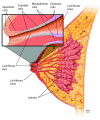Oncologic Safety of Prophylactic Nipple-Sparing Mastectomy in a Population With BRCA Mutations: A Multi-institutional Study
- PMID: 28903167
- PMCID: PMC5838709
- DOI: 10.1001/jamasurg.2017.3422
Oncologic Safety of Prophylactic Nipple-Sparing Mastectomy in a Population With BRCA Mutations: A Multi-institutional Study
Abstract
Importance: Nipple-sparing mastectomy (NSM) offers superior cosmetic outcomes and has been gaining wide acceptance; however, its role among patients with BRCA mutations remains controversial.
Objective: To report on the oncologic safety of NSM and provide evidence-based data to patients and health care professionals regarding preservation of the nipple-areolar complex during a risk-reducing mastectomy in a population with BRCA mutations.
Design, setting, and participants: We retrospectively reviewed the outcomes of 9 institutions' experience with prophylactic NSM from 1968 to 2013 in a cohort of patients with BRCA mutations. Patients with breast cancer were included if they underwent contralateral risk-reducing mastectomy; however, only the prophylactic side was considered in the analysis. Patients found to have an occult primary breast cancer at the time of risk-reducing mastectomy, those having variant(s) of unknown significance, and those undergoing free nipple grafts were excluded.
Main outcomes and measures: The primary outcome measure was development of a new breast cancer after risk-reducing NSM. Three reference data sources were used to model the expected number of events, and this was compared with our observed number of events.
Results: A total of 548 risk-reducing NSMs in 346 patients were performed at 9 institutions. The median age at NSM was 41 years (interquartile range, 34.5-47.5 years). Bilateral prophylactic NSMs were performed in 202 patients (58.4%), and 144 patients (41.6%) underwent a unilateral risk-reducing NSM secondary to cancer in the contralateral breast. Overall, 201 patients with BRCA1 mutations and 145 with BRCA2 mutations were included. With median and mean follow-up of 34 and 56 months, respectively, no ipsilateral breast cancers occurred after prophylactic NSM. Breast cancer did not develop in any patients undergoing bilateral risk-reducing NSMs. Using risk models for BRCA1/2 mutation carriers, approximately 22 new primary breast cancers were expected without prophylactic NSM. Prophylactic NSM resulted in a significant reduction in breast cancer events (test of observed vs expected events, P < .001).
Conclusions and relevance: Nipple-sparing mastectomies are highly preventive against breast cancer in a BRCA population. Although the follow-up remains relatively short, NSM should be offered as a breast cancer risk-reducing strategy to appropriate patients with BRCA mutations.
Conflict of interest statement
Figures


Comment in
-
When Is a Little Breast Tissue Too Much?: Nipple-Sparing Risk-Reducing Mastectomy in BRCA Carriers.JAMA Surg. 2018 Feb 1;153(2):129. doi: 10.1001/jamasurg.2017.3438. JAMA Surg. 2018. PMID: 28903136 No abstract available.
References
-
- Krajewski AC, Boughey JC, Degnim AC, et al. Expanded indications and improved outcomes for nipple-sparing mastectomy over time. Ann Surg Oncol. 2015;22(10):3317-3323. - PubMed
-
- Heemskerk-Gerritsen BA, Menke-Pluijmers MB, Jager A, et al. Substantial breast cancer risk reduction and potential survival benefit after bilateral mastectomy when compared with surveillance in healthy BRCA1 and BRCA2 mutation carriers: a prospective analysis. Ann Oncol. 2013;24(8):2029-2035. - PubMed
-
- De Felice F, Marchetti C, Musella A, et al. Bilateral risk-reduction mastectomy in BRCA1 and BRCA2 mutation carriers: a meta-analysis. Ann Surg Oncol. 2015;22(9):2876-2880. - PubMed
-
- Ludwig KK, Neuner J, Butler A, Geurts JL, Kong AL. Risk reduction and survival benefit of prophylactic surgery in BRCA mutation carriers: a systematic review. Am J Surg. 2016;212(4):660-669. - PubMed
Publication types
MeSH terms
Grants and funding
LinkOut - more resources
Full Text Sources
Other Literature Sources
Miscellaneous

